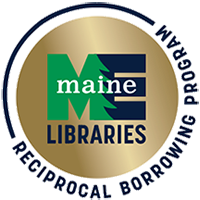Home → For Libraries →Maine Reciprocal Borrowing Program→ FAQs for Library Staff

Frequently Asked Questions About the Maine Reciprocal Borrowing Program
Information for Library Staff
The following list of frequently asked questions is taken from information previously shared with the library community. Additional information including staff training aids and tools for promoting the program can be found on the Reciprocal Borrowing Program Resource Page.
How will this work at the circulation desk?
Checking out: Please see the up step-by-step guide, but the short answer is that you will look up the patron's library on the registry to confirm their participation and what system they're part of. Then, if the patron is from a library within your local system, you'll check out just like normal. If they're from another MaineCat library, then you'll use the "Visiting Patron" function and check out that way.
Checking in: Check in just the same as any other item returned if they scan. If they don't scan, see the next FAQ.
How do we handle items returned to us that do not show up when we scan the barcode to check in?
If you have an item returned to your library that doesn't show any info when you scan the barcode, simply send it back to the owning library. You can identify the home library either by stamps, text on the barcode, or by looking up the unique barcode leader on the barcode registry.
How do we know if a patron is in good standing at their home library? Or how do we make sure a delinquent patron doesn't walk in to borrow at another library?
The system recognizes and prevents checkouts from patrons who have expired accounts or patron blocks on their accounts. Within your system, it will show you the blocks the same as your own patrons. Through "visiting patron," it will give a message saying that the patron is unable to check out that item and to check with their home library (similar to the message you would get when requesting through MaineCat catalog).
What will transactions look like in our system?
Once the item is checked out, walk-in transactions will look exactly the same as if the item had gone through delivery to the patron. In fact, they are indistinguishable once the check-out has happened.
What are the loan rules for walk-in items?
Walk-in transactions use the same loan rules as items sent through delivery.
How are overdue notices/bills for the patron generated?
Since they're coming from the same loan rules, notices and bills are generated and sent to the patron the same as if they had been send through delivery.
How are unreturned/lost items handled?
Charging for lost/unreturned items will be exactly the same as if the item was borrowed through delivery. In fact, walk-in billed items will be indistinguishable from items borrowed through delivery.
What about digital resources available via a library’s webpage with a card?
The program is for “physical” items only – not digital content available via a library’s website.
How will we know who is participating?
We will have a registry of participants listed online. After the pilot starts, the participating libraries will be set, so you don't need to worry about it fluctuating during the year.
